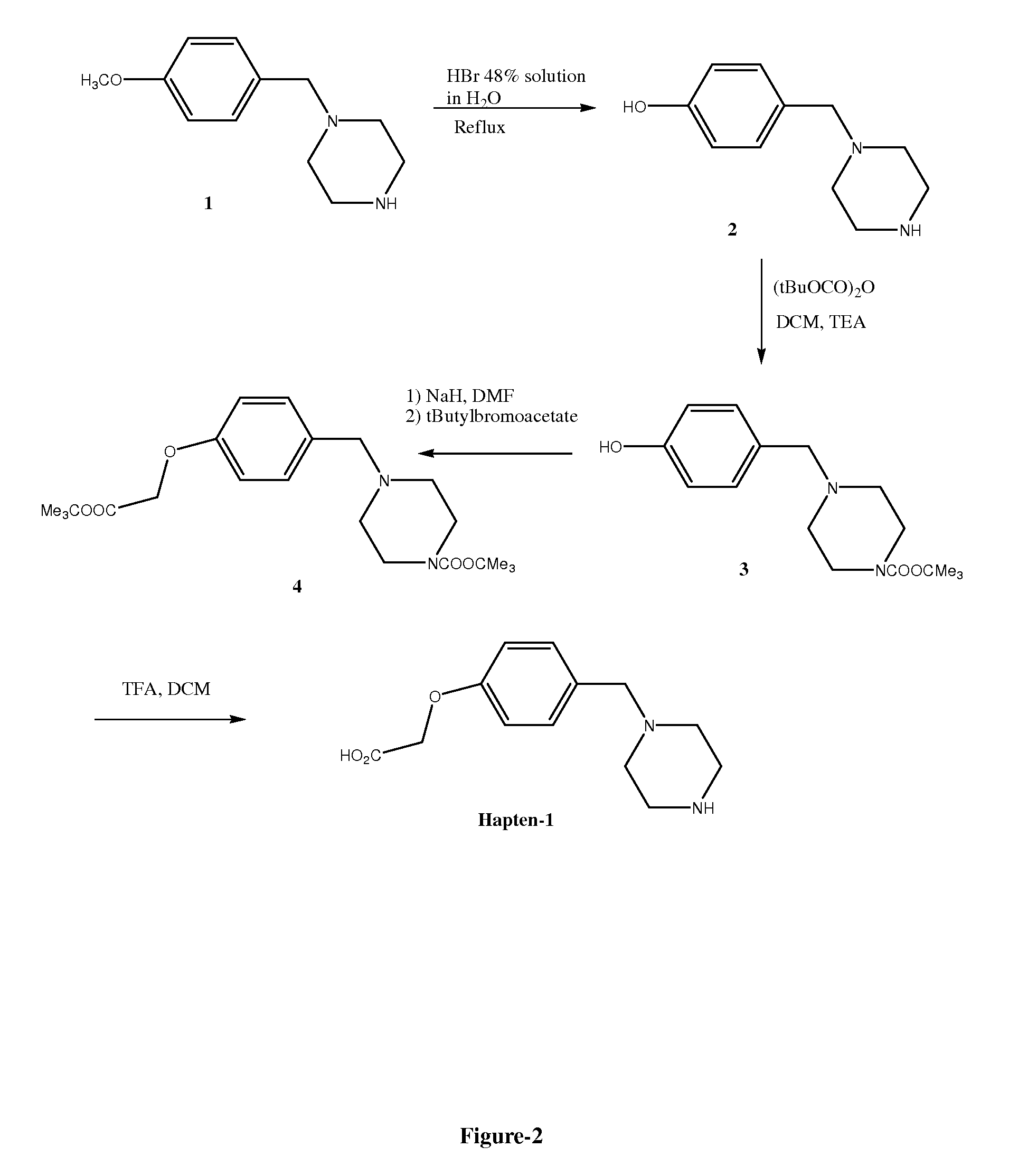Assay for benzylpiperazine and metabolites
a technology of benzylpiperazine and metabolites, which is applied in the field of piperazine derivatives, can solve the problems of high equipment and highly trained staff, and no data are provided for the detection of metabolites
- Summary
- Abstract
- Description
- Claims
- Application Information
AI Technical Summary
Benefits of technology
Problems solved by technology
Method used
Image
Examples
example 1
Preparation of 4-hydroxybenzylpiperazine dihydrobromide 2
[0102]To a solution of hydrobromic acid 48% in water (100 ml) was added 4-methoxybenzylpiperazine hydrochloride 1 (10 g, 41.2 mM) and the suspension was heated at reflux for 4 hours. The solution was then cooled to room temperature and concentrated to dryness to give a solid. Water was then added to the solid and the solution was stirred for 1 hour. The solid was then filtered, washed by water and dried at high vacuum to give the 4-hydroxybenzylpiperazine dihydrobromide 2 (6.3 g, 43.2%)
example 2
Preparation of N-boc-4-hydroxybenzylpiperazine 3
[0103]To a suspension of 4-hydroxybenzylpiperazine dihydrobromide 2 (6 g, 18.9 mM) in dichloromethane (150 ml) was added TEA (3.15 ml, 22.7 mM) and BOC anhydride (4.9 g, 22.6 mM) and the mixture was stirred at room temperature overnight. The solution was then washed by water (1×100ml), brine (1×100 ml), dried over sodium sulphate, filtered and concentrated to dryness. The crude product obtained was purified by flash chromatography on silica gel using ethyl acetate / hexane (50 / 50) to give the N-boc-4-hydroxybenzylpiperazine 3 (4.1 g, 74.2%).
example 3
Preparation of the Ester 4
[0104]To a suspension of sodium hydride (NaH) (0.551 g, 16.4 mm) in dimethylformamide (DMF) (50 ml) under nitrogen was added drop-wise a solution of N-boc-4-hydoxybenzylpiperazine 3 (4.0 g, 13.7 mM) in DMF (25 ml) and the mixture was stirred and heated at 60° C. for 1 hour. The mixture was then cooled to room temperature and to it was added drop-wise a solution of tert-butyl bromoacetate (3.2 g, 16.4 mM) in DMF (25 ml) and the mixture was stirred and heated at 60° C. for 4 hours. The solution was then cooled to room temperature (RT) and the DMF was removed under vacuum. Ethyl acetate (200 ml) was added to the crude product and then washed by water (100 ml) and brine. The solution was then dried over sodium sulphate, filtered and concentrated to dryness. The crude product obtained was purified by chromatography on silica gel using ethyl acetate / hexane (1 / 1) to give the ester 4 (4.0 g, 72%) as a clear oil.
PUM
| Property | Measurement | Unit |
|---|---|---|
| elimination half life | aaaaa | aaaaa |
| elimination half life | aaaaa | aaaaa |
| concentrations | aaaaa | aaaaa |
Abstract
Description
Claims
Application Information
 Login to View More
Login to View More - R&D
- Intellectual Property
- Life Sciences
- Materials
- Tech Scout
- Unparalleled Data Quality
- Higher Quality Content
- 60% Fewer Hallucinations
Browse by: Latest US Patents, China's latest patents, Technical Efficacy Thesaurus, Application Domain, Technology Topic, Popular Technical Reports.
© 2025 PatSnap. All rights reserved.Legal|Privacy policy|Modern Slavery Act Transparency Statement|Sitemap|About US| Contact US: help@patsnap.com



